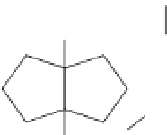Chemistry Reference
In-Depth Information
6.4 FLAVONE GLYCOSIDES
There are numerous examples in nature of flavonoid glycosides. As an example, in
Traditional Chinese Medicine, three major flavone glycosides have been isolated
from the leaves of the ginkgo tree,
Ginkgo biloba,
and these compounds are shown
in Figure 6.4. Upon extraction from the leaves, three flavone glycosides are isolated.
Interestingly, although the glycosides are isolated intact, there has been a preference
to perform the chemical analysis of these compounds on their respective aglycones
by hydrolysis of the isolated glycosides. Thus, the glycosides, upon hydrolysis yield
the corresponding aglycones: quercetin, kaempferol, and isorhamnetin in a ratio of
7:6:1 (see Figure 6.5).
It should be noted that ginkgo leaves contain another important biologically active
class of compounds but are not related to the flavonoids: a unique set of terpenoids
known as the ginkgolides. Ginkgolides are believed to be potent antagonists against
the platelet-activating factor and help prevent platelet aggregation and blood clotting.
Active Constituents of Ginkgo Biloba
H
H
Me
O
O
R
1
O
O
O
O
O
O
O
O
OH
C(Me)
3
O
O
OH
C(Me)
3
H
R
2
O
OH
H
R
3
H
Ginkgolide Structures
Bilobalide
R
1
R
2
R
3
Ginkgolide A:
Ginkgolide B:
Ginkgolide C:
Ginkgolide J:
Ginkgolide M:
OH
OH
OH
OH
H
H
OH
OH
H
OH
H
H
OH
OH
OH
R
OH
HO
O
O—One to three
sugar units
OH
O
Flavonol structures
Kaempferol derivatives: R = H
Quercetin derivatives: R = OH
Isorhamnetin derivatives: R = OMe
FIGURE 6.4
Ginkogolide and flavone glycosides found in ginkgo leaves.






























Search WWH ::

Custom Search